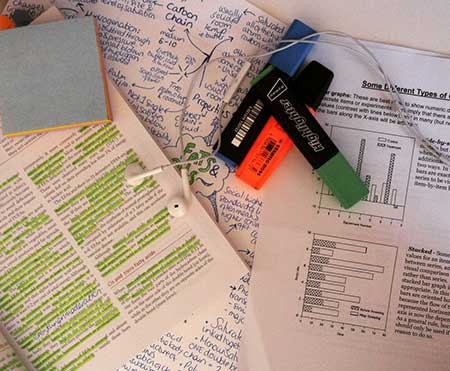
Are you revising in a way that can get the best out of you?
Do you usually spend the majority of your revision thinking “this isn’t going in” and “this is a waste of time – I’m not learning anything!”?
Thought so. We’ve all been there when we feel like we are constantly hitting a brick wall with our revision and getting absolutely nowhere. You can get yourself into such a mess which only adds to the stress and pressure of exams, or some even give up all hope and decide to wing the exam. Either way, it doesn’t usually end well. Poor grades and a slight mental breakdown spring to mind.
This year, try something different. Before you get started with your revision, look at how you revise. Every student learns differently, however, there are three distinct types of learning – auditory, visual and kinaesthetic. Whilst you may be a combination of the three, there is usually always one type which works the best for you. Taking the time to find out which way you learn best can help you revise more efficiently, learn and remember more – which, hey presto, can help you perform better in exams and therefore improve your grades. Simple!
Have a little read below to find out what type of learner you are…
Auditory
Do you prefer to listen to information, data and discuss rather than reading and writing?
Signs that you are an auditory learner:
-
Enjoy lectures: you like to have your voice heard in any debates, discussions and always put your hand up when you’ve got a question.
-
You work well in groups.
-
Confident with standing up in front of people, for example presentations.
-
Tend to struggle with reading and writing assignments.
If that’s you, then read below for some great methods for successful revision:
-
Try to organise group study sessions with other auditory learners – you’ll thrive in all the discussion and knowledge being passed around.
-
Recite any key facts, dates or passages you need to know to yourself. Or get a housemate to listen or test you.
-
Search the library, YouTube or catch-up TV for any documentaries on your revision subjects – get comfy, relax and watch. Record lectures – one student in my lectures has recorded every single lecture since the start of year one, and now I know why! Plus you’ll never be left thinking, what did my lecturer say again?
Visual
Do you find reading books, looking at graphs and watching practical demonstrations easier to understand?
Tell tale signs of a visual learner:
-
Have difficulty listening in lectures and struggle participating in group work and discussions.
-
Always prefer working individually.
-
Using highlighters and coloured pens when making notes and revising.
-
Always making lists.
How to revise as a visual learner:
-
Making timelines to demonstrate a process.
-
Drawing out diagrams to explain a process, or spider diagrams to display information.
Kinaesthetic
Are you “hands on” with your revision? Do you enjoy practical work?
Signs of being a kinaesthetic learner:
-
Fidgety, especially in lectures.
-
Struggle with spelling and grammar
-
Enjoys practical sessions in labs, kitchens or the field.
So how can I revise if I find sitting still difficult?
-
Set yourself multiple choice questions to test yourself on.
-
Try visiting educational places, such as museums.
-
Use flashcards to help remember key dates, names or figures.
-
Rather than forcing yourself to (unsuccessfully) revise for hours on end, set a revision plan for each day. Revise in small, efficient chunks then give yourself a small break.
Hopefully this blog has shone some light on your revision techniques, which will hopefully result in a smoother exam period! Have you got any unusual revision methods you’d like to share with the Studentrecipes community? Don’t forget to comment below!
Stay tuned at Studentrecipes.com for more blogs that will help you through the assessment period…
Explore More:Uncategorized
